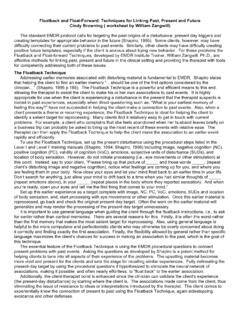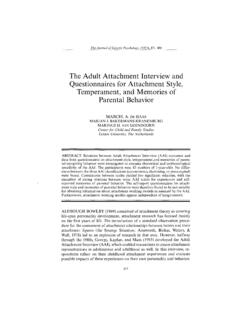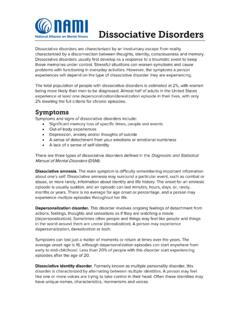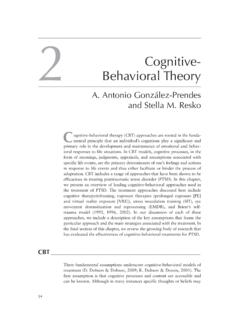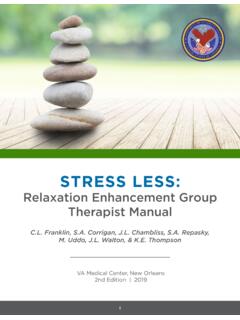Transcription of MARK GRANT’S EMDR PAIN PROTOCOL 1. Preamble
1 MARK GRANT S EMDR pain PROTOCOL 1. Preamble : Prior to commencing reprocessing, explain pain in terms of information processing model. For example: " pain can occur for many reasons, pain is normally a signal that something is wrong. However, sometimes pain can continue longer than expected. Long-term pain can lead to changes in the nervous system, which can maintain the pain . In a way, the pain becomes "locked" in the nervous system. EMDR is a means of stimulating the nervous system to help it change the pain responses. We can't predict how your nervous system will respond to the EMDR stimulation, so try and adopt an open mind and just notice the sensations of your pain as best you can. Initially, the intensity of the pain may not seem to change, or it may even increase, this is just the pain response shifting in response to the stimulation.
2 However, if the pain does become too strong, just raise your hand like this (show stop signal). Remember your nervous system knows what to do, so there's no need to try and make it happen, just notice and just let whatever happens happen. " "What we will be doing often is a simple check on what you are experiencing. I need to know from you exactly what is going on, with as clear feedback as possible. Sometimes things will change and sometimes they won't. There are no 'supposed to's' . Just notice and just let whatever happens happen." (Optional additional metaphor; "Just for now, I want you to really notice your pain , all the things about it, imagine you're a scientist just observing it.") 2. EMDR pain 'Target': 'Can you describe the pain as you feel it now?
3 Vague descriptions ( , "a dull ache") are generally not adequate as targets for reprocessing. Suggest descriptive terms such as size, shape, color, temperature. This helps client develop a meaningful cognitive representation of their pain . Avoid creative use of imagery, suggestions; material must be meaningful for client. Getting the client to draw a picture of their pain can be helpful. 3. Negative Cognition: "Are there any words about yourself that go with the pain ? What s it telling you? 4. Positive Cognition: "What would you like to be able to say about yourself when you think of the pain ?" (A positive cognition is desirable but not essential, as it can be elicited following reprocessing.) 5. Validity of Cognition (VoC): When you think of the pain , how true do those words (repeat the positive cognition above) feel to you now on a scale of 1-7 where 1 feels completely false and 7 feels completely true?
4 6. Emotions/Feelings: "Is there a feeling that goes with the pain ?" 7. SUD's ( pain rating): "On a scale of 0-10 where 0 is no discomfort, and 10 is the highest discomfort or distress you can imagine, how intense does the pain feel to you right now?" 8. Location: "Where do you feel the pain in your body?" 9. Desensitization: "Now I'd like you to focus on the pain the way you've just described it to me, at the same time as watching my fingers, and just let whatever happens notice." "What do you notice now?" If client reports differences, elicit details and re-stimulate using what they reported as a target. Responses like "it feels better," are okay, but asking for more details will elicit better target for reprocessing. : "..but how does it feel better, what feels different about it?
5 " When you get a response that's something concrete ( "softer, ") you have a better target with which to continue processing. Instruct client to "notice that" and re-stimulate. Never accept responses like "nothing" or "it's the same". These are analyses rather than direct reports, and give you nothing to reprocess. Say, "yes okay, but I need to know exactly what you are experiencing, like when you described it before we started the eye- movement ." (see: 'dealing with blockages') SUD's should be down to an acceptable level for the client. Before proceeding to installation stage. An acceptable level of pain may be anywhere between 0 and a 4 or 5. 10. Installation: Antidote Imagery A. When client reports differences in pain or changes in way its perceived, ask questions to build a resource out of the change ; ".
6 So what s come in its place? ..what s there now where the pain was before?" Sometimes, when the pain doesn't changes of its own accord, it may be necessary to instruct the client to "Think of something that could take the pain away or make it better. Don't worry about whether it seems realistic or not--just let your imagination run wild." Once you obtain something concrete, ( : smoother, softer, smaller etc.) re-stimulate. If change continues, after a couple more sets, ask; "what s that like?" "what does it remind you of? B. Pair a word with the metaphor and install. : "Is there a word that goes with how you feel when you think of that image?" Continue doing bilateral stimulation until you are getting a regular effect. 11. Positive Cognition: "When you think of the pain now, how true do those words (repeat the positive cognition) feel to you now on a scale of 1-7 where 1 feels completely false and 7 feels completely true?
7 " NB: The positive cognition may have changed. Acknowledgement: PROTOCOL is adapted from the basic EMDR trauma PROTOCOL as developed by F. Shapiro (1995)



